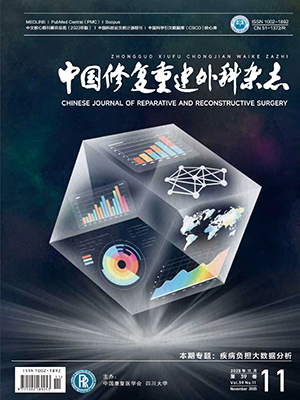Objective To investigate the effect of the serum from severe burn patients on the biology characteristics of human umbilical cord mesenchymal stem cells (hUCMSCs) in vitro, so as to explore the feasibility of hUCMSCs transplantation for treating severe burn. Methods The 3rd passage of hUCMSCs were randomly divided into 3 groups: 10% fetal bovine serum group (group A), 10% normal serum group (group B), and 10% burn serum group (group C). At 24 hours, 72 hours, and 6 days after culture, the cell morphology and density were observed by inverted microscope; the cell proliferation was assessed by MTT; after 6 days of culture, the cell cycle by propidium iodide staining and flow cytometry, the apoptosis by acridine orange/ethidium bromide staining, and the cell senescence by β-galactosidase staining; the levels of tumor necrosis factor α (TNF-α), interleukin 1 (IL-1), platelet-derived growth factor (PDGF), and insulin-like growth factor 1 (IGF-1) in serum were detected by a double-antibody sandwich ELISA kit. Results hUCMSCs were long spindle/polygon in 3 groups. The cell fusion of group C was obviously faster than that in group A and group B. The cell proliferation curves showed that the velocity and number of cell proliferation in group C were significantly higher than those in group A and group B at 2-6 days after culture (P lt; 0.05). The rates of proliferation period (S) of hUCMSCs were 9.21% ± 1.02%, 11.79% ± 1.87%, and 20.54% ± 2.03%, respectively in groups A, B, and C at 6 days, and group C was significantly higher than that of group A and group B (P lt; 0.05). The hUCMSCs showed normal morphology and structure in 3 groups, and no apoptosis cells was observed. The positive cells percentage of group C (2.6% ± 0.1%) was significantly lower than that of group A (4.8% ± 0.2%) and group B (3.8% ± 0.4%) (P lt; 0.05). The levels of TNF-α, IL-1, PDGF, and IGF-1 in group C were significantly higher than those in group B (P lt; 0.05). Conclusion The higher levels of cytokines in serum from the severe burn patients can significantly stimulate hUCMSCs proliferation, prevent cells apoptosis, and reduce cells senescence. Therefore, it is feasible to use hUCMSCs transplantation for treating severe burn patients.
Citation: LIU Lingying,CHAI Jiake,HOU Yusen,DUAN Hongjie,YU Yonghui,YIN Huinan,HU Quan,FAN Jun,DU Jundong.. EFFECT OF SERUM FROM SEVERE BURN PATIENTS ON BIOLOGY CHARACTERISTICS OF HUMAN UMBILICAL CORD MESENCHYMAL STEM CELLS. Chinese Journal of Reparative and Reconstructive Surgery, 2013, 27(7): 769-774. doi: 10.7507/1002-1892.20130171 Copy
Copyright ? the editorial department of Chinese Journal of Reparative and Reconstructive Surgery of West China Medical Publisher. All rights reserved




